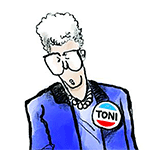Mike Vorel: As NFL draft nears, Seahawks' mission statement is obvious
Published in Football
SEATTLE — Here’s a multiple-choice question for a Seattle sports fan.
Let’s say a local team enters its offseason with a glaring weakness. Rather than addressing it by adding players to improve the area, the team instead sits still, to the righteous indignation of its audience. The team tells those increasingly frustrated fans to keep the faith, that the same players will improve with new coaching and an amended system or approach.
Which team and weakness fits the bill?
A.) The Mariners’ infield offense
B.) The Seahawks’ offensive line
C.) Both
The answer, for now, is only A.
Seahawks president of football operations and general manager John Schneider still has time to improve the offensive line.
Which, yes, you’ve heard before.
But when the NFL draft arrives Thursday night, the Seahawks’ mission statement should be obvious. Under previous offensive coordinator Ryan Grubb, Seattle ranked 17th in the NFL in yards per carry (4.2) and 28 th in rushing yards per game (95.7), and surrendered the third-most sacks (54). Running backs Kenneth Walker III and Zach Charbonnet averaged 1.7 and 2.0 yards before contact, respectively, far below the league average of 2.5. Though their grades are subjective, Pro Football Focus slotted Seattle 24th in run blocking, 26th in pass blocking and 31 st in overall offensive line play.
By most any available metric, it wasn’t good enough.
Which doesn’t mean the Seahawks must nab an offensive lineman with the 18th overall pick — though North Dakota State’s Grey Zabel, Texas’ Kelvin Banks Jr., Alabama’s Tyler Booker and Ohio State’s Donovan Jackson all look like eligible options. If Seattle springs for, say, a wide receiver such as Arizona’s Tetairoa McMillan or Texas’ Matthew Golden on Thursday, that shouldn’t produce widespread panic across the Pacific Northwest.
The Seahawks would be wise to add depth at wide receiver, tight end and cornerback.
But with five picks in the top 92, they better invest in the offensive line early and often.
Or else.
“Ohio State’s Donovan Jackson, Tyler Booker and Grey Zabel (Zabel can play guard or center) are this year’s ‘big three’ inside, and there is a noticeable drop-off after those players,” NFL.com analyst Lance Zierlein said of the draft’s interior options. “(Georgia’s) Tate Ratledge and (West Virginia’s) Wyatt Milum are brawling future starting guards as probable Day 2 selections, but if your team doesn’t prioritize the interior inside the first 100-to-110 picks, it might as well wait until the fifth round for a depth-level prospect.”
The Seahawks can’t afford to wait.
Which, by the way, is how they’ve often approached the position. Since Schneider arrived in 2010, Seattle has drafted 28 offensive linemen — only six of which were taken in the top two rounds. That’s 20.7% of their 29 first- and second-round picks over those 15 classes.
And with heaping holes at guard — and, depending on your opinion of Olu Oluwatimi, possibly center as well — Schneider can’t claim it isn’t a deep class at those particular positions. If that’s the case, Seattle should have made more pressing pursuits of free agents such as Mekhi Becton, Teven Jenkins, Lucas Patrick or Dillon Radunz — all of whom eventually signed elsewhere.
Of course, it’s possible that new offensive coordinator Klint Kubiak, offensive line coach John Benton and run game coordinator Rick Dennison can help lift the team’s existing interior linemen — guys like Oluwatimi, Jalen Sundell, Christian Haynes, Sataoa Laumea and Anthony Bradford. Kubiak’s outside zone scheme could also better fit the Seahawks’ strengths and hide their weaknesses.
But in March, Schneider acknowledged the need for upgrades, stating: “Yeah, the offensive line — definitely, we need to (address it). Everybody sees it.”
Everybody, indeed. As CBS Sports analyst Tom Fornelli wrote in his most recent mock draft: “If the Seahawks don’t fix the interior of their offensive line after bringing in [quarterback] Sam Darnold they’re destroying any chance of competing in 2025.”
The best way to improve your play is to bring in better players. Or at least, to cultivate competition.
So, don’t outsmart yourself.
Don’t fall for the fairy dust on a flawed quarterback — guys like Ole Miss’ Jaxson Dart, Alabama’s Jalen Milroe or Louisville’s Tyler Shough. Though Seattle could certainly add a developmental prospect later in the draft, none of the above is worthy of a first-round flier.
Plus, last week’s signing of Drew Lock already crowds the Seahawks quarterback room, which includes backups Sam Howell and Jaren Hall. Milroe (an elite athlete with an erratic arm) and Shough (a 25-year-old with injury issues and one full season as a starter) took pre-draft visits to Seattle but feel more like lottery tickets than the future of a franchise.
In an interview Thursday on 710 AM Seattle, Schneider said Lock’s signing wouldn’t preclude the Seahawks from selecting a signal caller.
“Drew had other opportunities, so we figured we better wrap this up, put a bow on it, get him in the building, and then let’s see what happens in the draft,” he said. “Because it’s difficult to find that right fit at quarterback as you move through the [draft] process.”
Besides, the Seahawks have more pressing priorities.
Like, say, protecting Darnold — who they just signed to a three-year, $100.5 million deal — while investing in the foundation of Kubiak’s run-first scheme.
Or avoiding becoming the answer to a question Seattle sports fans shouldn’t have to ask.
____
©2025 The Seattle Times. Visit seattletimes.com. Distributed by Tribune Content Agency, LLC.







Comments